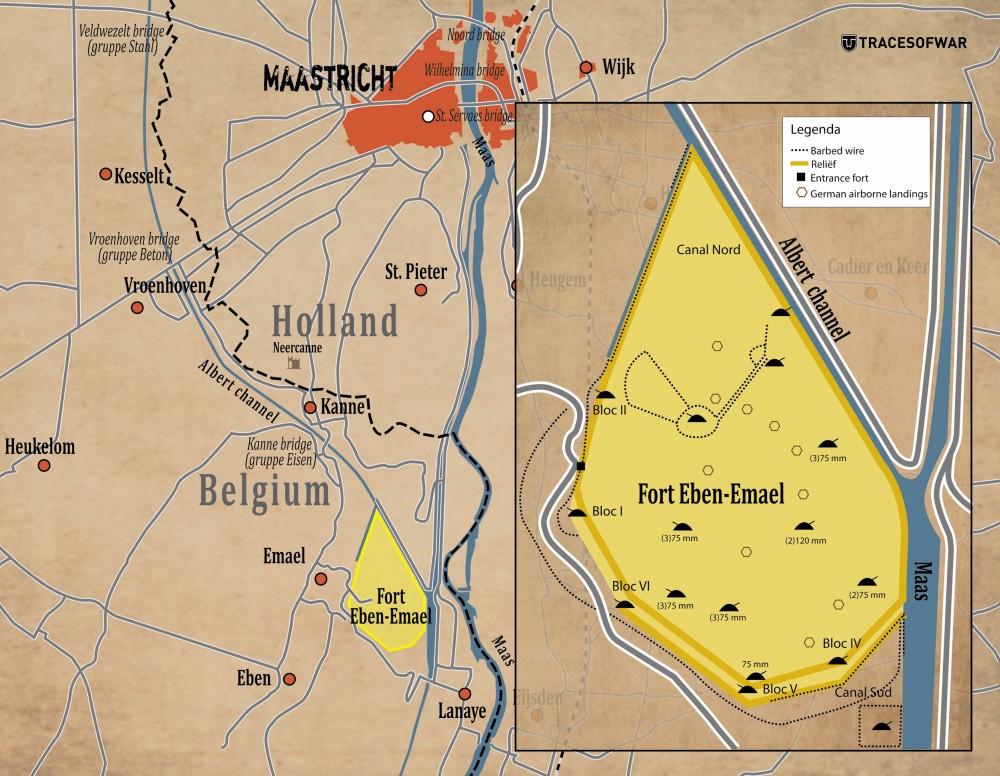Please find driving directions below the main text
Bank account of “National Trust Belgium” (NTAB)
BE17 0016 2443 2021
Fort Eben-Emael and Vroenhoven Bridge
The Battle of Belgium and the Albert Canal
On Friday, February 23 we will learn about the first campaign of the Second World War on Belgian territory and discover the Belgian inland waterways. We will visit two locations that played a prominent role during the invasion of Belgium in May 1940, and we will learn about the construction of the Albert Canal.
We begin the day at Vroenhoven Bridge in the province of Limburg, one of two bridges, along with Veldwezelt, taken on 10-12 May 1940, as the German army invaded Belgium, the Netherlands and Luxembourg. The Belgian army managed to destroy a third bridge, at Kanne, to prevent it from being taken.
At the Brug van Vroenhoven experience centre, we learn about the invasion, the 18 Days’ Campaign (10-28 May 1940), life in occupied Belgium and we discover a memorial to the victims of the campaign.
We also learn about Belgium’s waterways, with a particular focus on the Albert Canal, constructed during the 1930s to link the Meuse to the Scheldt and enlarged in the 1960s to become a key artery for commercial transport as well as a site for leisure activities.
After lunch at the centre’s restaurant, Onder de Brug, we make the short journey to Fort Eben-Emael in the province of Liège.
The fort was constructed during the 1930s and is now probably the largest and best-preserved underground fort of the Second World War. We will learn about the attack on the fort on 10 May 1940, when ten gliders landed in silence, taking the garrison by surprise, in the first strategic airborne operation using paratroopers ever attempted.
As well as discovering the garrison’s living quarters, the workshops, the officers’ mess and the infirmary, we shall see one of the DFS 230 gliders used by the German army in the Second World War. Reassembled from the wreckage of three gliders, it is one of only three DFS 230 gliders preserved in museums across the world.
Lunch at 12:30h, restaurant “ Onder de Brug” , Maastrichter steenweg 212, 3770 Riemst.
Two courses including 1 drink (wine /beer/soft drink/water) and coffee or tea . All additional drinks are at the expense of participants. Vegetarian or gluten free meals will be served to participants who indicated this at registration
If you have registered and paid for this event, let the organisers know, preferably by email ( andre.ceulemans6@telenet.be / tim.middleton.159@gmail.com ) and they will arrange for more detailed information and guidelines in the week preceding the outing ( e.g. list of participants, carpooling, lifts…).
How to get there:
by car : from Brussels take the E40 to Leuven where you continue on the E314 to Genk/Hasselt. At the traffic junction in Lummen take the E313 to Luik/Hasselt. Get off at exit 32 and take the N79 to Riemst/Maastricht . When you reach the Albert Canal in Riemst/Vroenhoven turn right in the 18de Liniestraat. A ride of 115km which takes 1h30.
There is ample parking space on the 18de Liniestraat next to the museum.
As it is very difficult to reach Vroenenhoven bridge by public transport- it takes almost half a day to get there- the organizers would greatly appreciate that members/participants express their willingness to facilitate car-pooling as much as possible or communicate their readiness to offer a lift to participants or would-be participants who are less mobile.
More background information:
In Belgium the Second World War started on May 10, 1940 at the Vroenhoven bridge, at two other bridges nearby, at the fortress of Eben-Emael, in the cities of Maastricht and Tongeren. They were all the targets of one coordinated German surprise attack. The attackers were brought to the bridges and the fortress with gliders. The museum at the bridge of Vroenhoven and the remains of the fort of Eben-Emael tell this story.
Fort Eben-Emael is a vast military complex dug out in a marl hill between 1932 and 1935. In 1940, the fortress formed part of the Fortified Position of Liège, together with 3 other newly built modern forts, 8 upgraded older forts and a vast network of pillboxes and obstacles. It was built to protect the bridges over the River Meuse and the Albert canal to prevent a German invasion force from using the access roads and bridges to penetrate into central Belgium.
At dawn on 10 May 1940, ten large transport gliders carrying an elite unit of German paratroopers landed on the roof of the fortress. This was the world’s first ever airborne assault by special forces. There had been no official declaration of war yet.
During the night of 10 to 11 May 1940, German ground forces crossed the Albert canal and surrounded the fortress. The German attack succeeded to break through the Belgian positions on the Albert canal, which had a wide strategic effect.
As planned by German high command, French and British troops moved forward into central Belgium, clearing the way for the high-speed German thrust through the Ardennes. The result is well-known: allied troops were surrounded in Belgium and the British and French were pushed back to Dunkirk and Calais.

Assault on Belgium